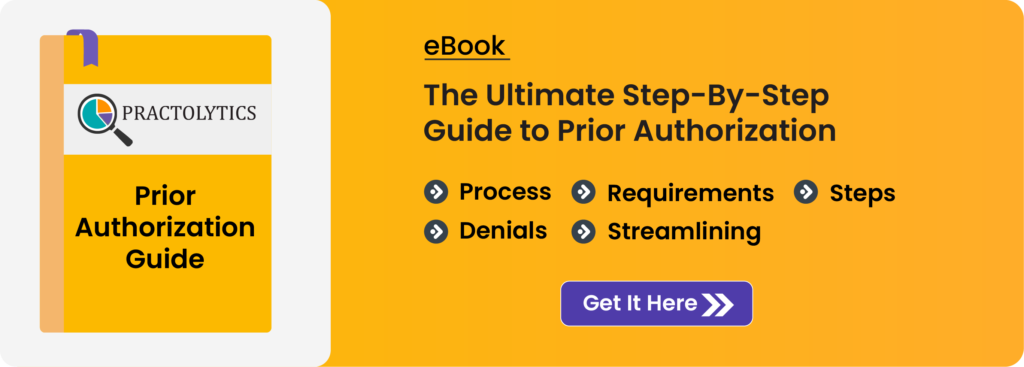Cost-Benefit Analysis of Outsourcing Prior Authorization in Healthcare Practices
Many healthcare practices now consider outsourcing the pre-approval process as a strategic move to streamline administrative tasks without compromising patient care. prior authorization (PA) is a step used by insurance companies to assess coverage for prescribed medical procedures, services, or medications. This procedure, essential yet taxing, often pushes healthcare providers towards considering external assistance. This article delves into the economic assessment of outsourcing prior authorization in healthcare settings, analyzing financial effects, staff workload, patient treatment, and operational streamlining.
Table of Contents
Understanding Prior Authorization
Approval before treatment is needed by health insurance for some medicines, procedures, or treatments. It checks if the care prescribed is necessary and cost-effective. The aim is to manage costs and avoid unnecessary treatments, but it involves lots of paperwork, talking to insurers, and takes up a lot of healthcare staff time.
The Burden of Prior Authorization on Healthcare Practices
The demands of pre-approval add a heavy administrative load to healthcare operations. Medical providers must dedicate extensive time and resources to handle this process. Personnel require training to navigate diverse insurance plans, keep up with policy adjustments, and engage effectively with insurance representatives. These responsibilities detract from patient-focused activities, contributing to heightened stress and fatigue among healthcare workers.
A recent research report from American Medical Association (AMA) found that doctors allocate about 14 hours weekly to tasks related to authorization before treatment. This amounts to almost two full workdays each week spent on administrative tasks rather than focusing on patient care. Additionally, the complex and varied nature of this process can lead to mistakes, delays, and rejected claims, affecting how patients are treated and their overall satisfaction.
The Case for Outsourcing Prior Authorization
Contracting out prior authorization involves engaging an external service provider to handle administrative duties related to the PA procedure. This method helps ease the workload on healthcare personnel and enhance operational effectiveness. It’s essential to evaluate economic advantages and disadvantages to determine the appropriateness of outsourcing for a specific practice.
Cost Analysis
Direct Costs
The direct expenses associated with outsourcing prior authorization involve payments made to an external service provider. These expenditures can differ depending on the service provider and the specific service levels. It is important to evaluate and compare costs among various providers and consider the potential financial benefits.
Indirect Costs
Indirect Costs could arise from limited oversight over the PA process, continuous interaction with the external provider, and potential interruptions during the changeover. However, these expenditures are usually counterbalanced by decreased administrative tasks and enhanced effectiveness.
Savings on Internal Resources
By using external services for prior authorization, healthcare practices can cut down on internal expenses such as personnel time, education, and technology systems. This enables them to allocate more resources to patient treatment, potentially enhancing patient results and contentment.
Benefit Analysis
Increased Efficiency
Contracting out prior authorization tasks can enhance the efficiency of managing this process. External service providers often possess specialized knowledge, efficient workflows, and advanced tools to handle these requests faster and with greater precision compared to internal resources. This can reduce delays and mistakes, resulting in expedited approvals and better patient outcomes.
Reduced Administrative Burden
Employing external support like physician assistants (PAs) offers substantial advantages by easing the administrative tasks of healthcare personnel. This leads to reduced stress and exhaustion, increased job contentment, and a heightened focus on patient well-being. It enables doctors and staff to dedicate more time to patient interaction and less to administrative duties, thereby enhancing care quality.
Cost Savings
Although outsourcing has expenses, it presents a considerable opportunity for financial savings. By minimizing the resources and time allocated to administrative duties, healthcare facilities can achieve notable cost reductions. These funds can be allocated to recruiting additional clinical personnel, enhancing technology, or broadening service offerings.
Improved Patient Outcomes
Optimizing the PA procedure can speed up approvals and reduce treatment interruptions, benefiting patient health by ensuring timely access to needed treatments. It also allows healthcare providers to focus more on patient well-being, leading to better overall patient satisfaction.
Compliance and Risk Management
External service providers possess up-to-date knowledge of regulations and compliance. They support healthcare practices in adhering to changing insurance policies and regulatory norms, thereby decreasing the chances of claim rejections and legal entanglements.
Challenges and Considerations in Outsourcing Prior Authorization
While the advantages of delegating prior authorization tasks are convincing, it’s crucial to assess possible hurdles and thoroughly analyze before finalizing a choice.
Choosing the Right Provider
Selecting the appropriate outsourcing partner is vital for the initiative’s success in healthcare practices. It’s important to conduct thorough research, evaluate the provider’s expertise, track record, and technology capabilities, and consider feedback from clients and references
Integration with Existing Systems
The external service provider must blend in perfectly with the practice’s current operations and processes. This demands good communication, coordination, and maybe some tweaks to ensure everything runs smoothly and collaboration continues seamlessly.
Maintaining Quality Control
While using external resources can boost efficiency, it’s important to maintain quality and ensure the PA process meets practice standards. Regular oversight, feedback, and assessing performance are vital to ensuring the external provider delivers the required service level.
Data Security and Privacy
Healthcare providers must ensure that the external service provider follows regulations related to data security and privacy, such as HIPAA. Safeguarding patient information is crucial, as any violations could result in significant legal and reputational risks.
Case Studies and Examples
To gain insights into the effects of subcontracting prior approval, let’s explore several real-world instances where healthcare organizations have effectively implemented this tactic.
Case Study 1: A Large Multispecialty Clinic
A sizable medical facility in the Midwest chose to contract out its prior authorization tasks to an external service provider. Before outsourcing, the clinic’s medical professionals and support staff were overwhelmed by the administrative duties of handling prior authorizations. This caused delays in patient treatment and raised stress levels. Outsourcing resulted in notable efficiency gains. The external provider managed prior authorization requests swiftly and accurately, leading to faster approvals and fewer rejections. This allowed doctors to spend more time with patients, improving the standard of care. Moreover, the clinic achieved significant cost savings by minimizing the necessity for additional administrative personnel and training.
Case Study 2: A Small Independent Practice
A small medical office in the Southeast faced challenges handling authorization procedures with a small team and limited resources. To ease the workload, the office decided to contract out this task to a specialized provider. The external provider introduced more efficient procedures and advanced technology, which reduced delays and mistakes. This led to better patient results. By outsourcing, the office saved money that was then used to upgrade medical equipment and expand services, improving patient care.
In healthcare practices, externalizing prior authorization tasks offers a viable remedy for the administrative complexities and inefficiencies of the PA procedure. Despite associated expenses, the potential benefits including improved efficiency, reduced administrative workload, cost effectiveness, and enhanced patient outcomes are significant.
Healthcare providers should carefully weigh the advantages and disadvantages, select an appropriate external service provider, and ensure seamless integration and rigorous quality assurance. This approach can lead to substantial improvements in operational efficiency and patient care, ultimately enhancing the overall healthcare provision.
Future Outlook
In the evolving healthcare sector, there is a growing need for effective and economical solutions such as externalizing prior authorization tasks. Innovations in technology, such as AI and machine learning, are poised to streamline the PA process and bolster service providers’ capacities. Healthcare facilities that embrace these advancements will be better prepared to navigate shifts in the healthcare landscape. Strategic externalization of prior authorization can alleviate administrative duties, improve patient services, increase staff contentment, and promote enduring viability amid healthcare complexities.
At Practolytics, we specialize in advanced services for managing healthcare revenue cycles, designed to optimize financial performance for your practice. Our proficiency in streamlining administrative tasks, including handling prior authorizations, allows your team to prioritize patient care while we manage billing and regulatory requirements. Partner with Practolytics to reduce administrative workload, improve financial liquidity, and enhance operational effectiveness, ensuring your practice excels in today’s healthcare environment.
ALSO READ – Understanding Prior Authorization for Medication: How Long Does It Take?
Talk to Medical Billing Expert Today — Get a Free Demo Now!






